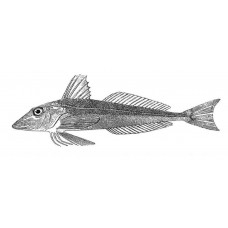Latin name
Eutrigla gurnardus
Other name
Eutrigla gurnardus
Identification
The elongated body of the gray gurnard is covered with fine scales; scales are absent from the throat and the base of the pectoral fins. The head is large, without scales, covered with bony plates. The forehead is flat and rather large, the upper lip is bipartite and protrudes above the lower lip. On the forehead, in deep eye sockets, are large, movable eyes, above which protrude sharp spikes, resembling horns, for defense against other predators. The lateral line is long and straight, with 72-77 scales, and curves slightly upward just behind the head. Along it is a series of small bony plates with a longitudinal keel ridge in the middle. The vertebrae are 37-39.
Features of fish fins
The two dorsal fins of these fishes are separated by a considerable gap. The first dorsal fin has 7-9 spiny non-branching rays and the second has 18-20 soft rays. The anal fin has 17-20 soft rays. The pectoral fins are shorter than those of the Tub gurnard, not reaching the beginning of the anal fin. They have 10 soft rays connected by webs and 3 free long rays. The pelvic fins are located on the thorax, with one hard and five soft rays. The tail fin is bifurcated. Along the base of the dorsal fins on each side of the body is a row of 27-29 bony plates.
Fish colouring
Adult gray gurnards are gray or brownish gray. Numerous white spots are scattered across the back and sides of the body. The belly and throat are silvery white. The first dorsal fin has a prominent rounded black spot. In juveniles, the body is red and the belly is grayish white. During spawning, the coloration of males is mottled and bright.
Distribution
The species is distributed in the northeastern Atlantic Ocean from Iceland and Norway to Morocco. It is found in the North Sea, the Baltic Sea, the Mediterranean Sea and the Black Sea.
Habitat
A marine species that prefers temperate climates. It inhabits depths from 10 to 340 meters, but usually at depths of 10-60 meters. Its juveniles inhabit shallow depths of 2-20 meters. It is sensitive to water temperature, so it is found near the coast from late April to mid-October. It has a benthic lifestyle and prefers sandy substrate.
Size
Grey gurnard can reach a length of 60 cm, usually around 30 cm. Maximum published weight: 956.00 g. Females are slightly longer than males.
Behavior
It is a bottom-dwelling fish, although it occasionally rises to the surface. It is found at considerable depths as well as near the shore. In coastal areas, it is most abundant from the beginning of June to the end of August; in deeper waters, it is caught in almost equal numbers throughout the year. They begin to move closer to shore as temperatures rise in April and move to greater depths in September. Gray gurnards are capable of producing sounds that are used to communicate between individuals as they forage for food.
Food and feeding habits
It is a predatory fish. It feeds on slow moving bottom dwellers such as fish, shrimp and crabs. When hunting, it uses the 3 long rays of its pectoral fins to feel for slow moving organisms in the sand. It usually hunts at depths of 10 to 20 meters. When choosing a victim, the predator lies on the bottom or under algae, most often on its border with clear water. Mackerel or shrimp is a favorite treat of the rooster. After spotting the fish, the rooster rushes forward with lightning speed, not giving its victim a second thought. When moving quickly, the Rooster's fins are composed and do not interfere with its movement.
Reproduction
Males reach sexual maturity at the age of 3 years with a body length of about 20 cm and females at the age of 4 years with a body length of about 24 cm. The spawning season lasts several months, from April to September in northern areas and from January to June in the southern part of the range. The fecundity is 200-300 thousand eggs. Eggs are small, 1.5 mm in diameter, with a fat droplet, floating. Juveniles lead a pelagic life until they reach 3 cm in length.
Fishing
Valuable commercial fish. It is harvested with bottom trawls and nets. The main fishery is in the North Sea.
Relationship with a person
Harmless. Fishing for gray gurnard is strictly prohibited. If such a fish is accidentally caught on a hook, it must be immediately released into the sea.
| Classification | |
| Phylum | Chordata |
| Class | Actinopterygii |
| Squad | Scorpaeniformes |
| Family | Triglidae |
| Genus | Eutrigla |
| Species | E. gurnardus |
| Features | |
| Conservation status | Least Concern |
| Habitat | Bottom |
| Life span, years | No information |
| Maximum body weight, kg | 0,956 |
| Maximum length, cm | 60 |
| Sailing speed, m/s | No information |
| Threat to people | Edible |
| Way of eating | Predator |
Grey gurnard
Tags: grey gurnard


